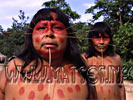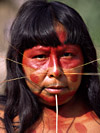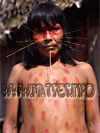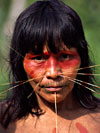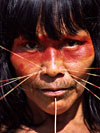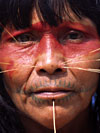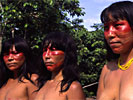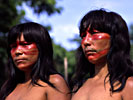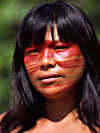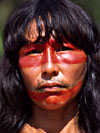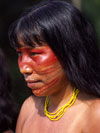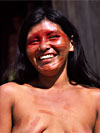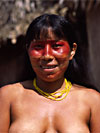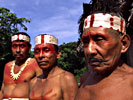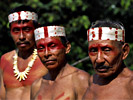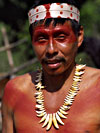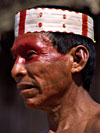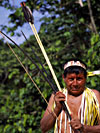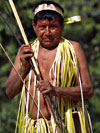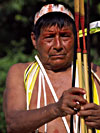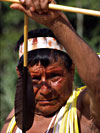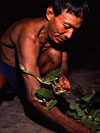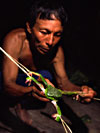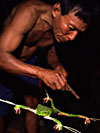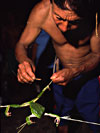|
Matses women still practice traditional body painting and decorations as do many
other indigenous Amazonian natives. By
tradition, female members of the Matsés tribe put decorations in the alae of
their noses in an attempt to imitate the look of feline whiskers, consequently
their tribe being frequently called the "Cat People." The “whiskers” are
actually fabricated out of rigid palm leaf fibers. The women do not always wear
these decorations, an example being after having a death in their immediate
family, in which case the woman does not sport these decorations during a
bereavement period of several months. To complement the nose piercings, women
often wear a piece of wood in a piercing below the lower lip. Younger women
often enhance their appearance by using longer sticks than the older.
Matses woman often wear their traditional piercings with female body painting.
Like the majority of Amazonian tribes in the Amazon River Basin, the Matses employ a red
pigment extracted from the annatto tree (Bixa orellana) in order to paint
their bodies. At times, the Matses women will mix this red pigment with animal
fat and the resultant combination creates a brilliant-red body paint. Female
body painting was particularly important because Matses women did not put on
clothing before making permanent contact with European cultures, as was the
custom of most pre-Columbian Amazonian tribes. In addition to having piercings
and practicing female body painting, Matses women traditionally have permanent
tattoos on their faces.
In contrast with some modern-day cultures, older Matses women are greatly
esteemed in Matsés culture for their intimate knowledge of nature and society.
In general, it is older woman who process foliage (harvested by men) and heal
with herbal remedies. Older Matses women have much understanding of traditional
remedies and their relationship to the animal spirits. Like most Amazonian
natives, the Matses are animists, believing that animal spirits play an important
role in illnesses and determine one’s wellbeing.
Matses society is divided into two principal social groups, the Worm Clan and
the Jaguar Clan. These two affiliations are hereditary and members of the Matses
tribe are generally either “jaguar-kind” or “worm-kind” people as determined by
the clan of their father (i.e., patrilineal). One’s clan determines one’s
role in Matses society, with only one clan being able to perform certain tasks.
A good example of a clan-specific task is the cultivation of maize. Only the
Worm Clan can grow maize because the Matses believe that if a person from the
Jaguar Clan was to do so, that the animal spirits would be offended, causing the
maize to dry up and die. These two moieties of Matses society are intimately
integrated, shaping one’s actions and way of life.
Despite their difficult past, the
Matses Indians can be a surprisingly welcoming and cheerful indigenous Amazonian
tribe. Related tribes, for instance the Matis, Shipibos and Marubos, are known for
being very sociable and demonstrate a harmonious Amazonian lifestyle. However at
one time, relations between the Matses and outsiders were very inhospitable,
with a virtual state of war existing between their communities and the outside
world. To understand the Matses people and what caused these hostile relations
between them and the outside would, you need to understand the history of the
colonization of the Amazon, particularly the period of the rubber boom and its
devastating effect on the indigenous people living there.
Similar to other Amazon tribes in the Javari River Valley,
Matses men are fearless in many ways and their way of life and rituals
frequently entail undergoing pain. However, Matses men are not violent and
examples of one man dying at the hands of another are very rare. Quarrels
between Matses men are normally settled in ritual wrestling contests rather than
by violent confrontations. Most quarrels between men involve women and the
relations between the sexes are complicated by the fact that the Matses are
polygamous with an older man typically having several wives.
Older Matses men can still remember when they raided outside communities for
metal tools and women. These attacks came about in response to their need for
resources to survive in their interfluvial rainforest environment. The attacks
by the Matses on outsiders and other Amazonian tribes peaked in the 1960s with the Matses attacking far
away communities on the Ucayali River. The members of some of these communities
(e.g. Requena) formed militias composed of civilians, law enforcement,
and military personnel. These Peruvian militias attacked the Matses communities
in the border region of Peru with Brazil, burning their homes and destroying
their crops. The Matses fled deep into the interfluvial forest, making their
survival even more difficult living away from the more abundant resources found
near the major rivers. In 1969, the Matses finally made peace with the outside
world when they allowed two female linguist-missionaries (Hattie Kneeland and
Harriet Fields) from the Summer Institute of Linguistics (SIL) to enter their
territory.
Presently, the Matses are experts in the manufacture and use of bows and arrows.
However, this was not always the case and before the invasion of their lands by
westerners, the Matses are thought to have exclusively used blowguns.
Anthropologists believe that the Matses tribe switched to bow and arrows as a
result of a need to defend themselves against intrusions into their territory by
rubber barons during the rubber boom era. Before he became infamous for his
abuse of Amazonian indigenous tribes on the Putumayo River, the rubber baron Julio Arana
was active in the Javari River Valley. It was in response to these invading
rubber barons and the necessity to protect their communities against them that
the Matses entirely abandoned the use of blowguns and equipped themselves with
bows and arrows.
Similar to neighboring Amazonian Indian tribes, the Matses have many rituals that involve the giving of “energy” from one person
to another. With few exceptions, these rituals are extremely agonizing and are
used by the Matses to increase one’s endurance and skill. Examples of these
rituals are blowing “snuff” (në-në) into one’s nose, whippings with urticating plants,
being stung by ants, or receiving injections of frog venom (Phyllomedusa
bicolor). Typically, the energy donor is an older male that possesses much
energy while the receiver is most commonly a male youth. The Matses believe that
the energy receiver will become more energetic and possess enhanced work and
hunting skills. The utilization of this frog venom (referred to as sapo,
kambo, kampu, or acate) is shared by numerous other Amazonian tribes,
including the Matis, Kanamari, Kaxinawa, Katukina, Kulina, Yaminawa, Marubo, and
Ticuna tribes.
Please be aware that currently it is not possible to enter the Matses Native
Community
with commercial tour guides who have recently been prohibited by the Matses
chiefs from entering their indigenous
territory.
However, it is still possible to meet the Matses people by having the Matses
themselves act as your hosts.
If you would like to obtain more information and resources (books, maps, and
articles) on the Matses people and learn how you can meet them, please email
info(at)matses.info.
For more information about the Matsés, please
contact info(at)matses.info
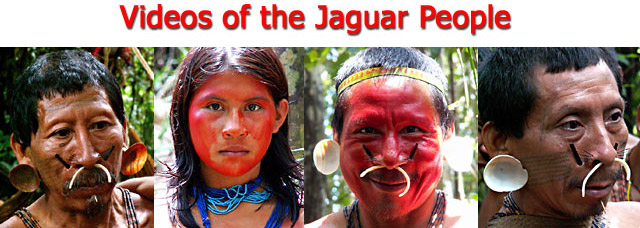
|
